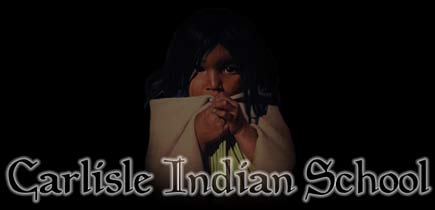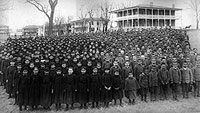 |
|
For a larger version
click on image
|
| The Carlisle Indian Industrial School was founded
by Richard Henry Pratt. In an address to a convention of Baptist ministers
in 1883 Pratt wrote: "In Indian civilization I am a Baptist, because
I believe in immersing the Indians in our civilization and when we get
them under holding them there until they are thoroughly soaked."
So Pratt began his aggressive and relentless quest for a school of his own to begin his work. He lobbied Washington; he contacted his wealthy supporters in the East and convinced the powers that be that his experiment would be a success. He would take Indian children from the reservations, remove them to a school far away from tribal influences, and transform them. A former cavalry post, Carlisle Barracks in central Pennsylvania, was chosen as base site of his school. Pratt had hired a full complement of staff, both for academic and industrial instruction. They had been carefully selected and were ready to begin as soon as the children arrived. They began their process of assimilation. One of their first responsibilities was to hire a barber to cut the children's long hair. For the Lakota, the cutting of hair was symbolic of mourning and there was much wailing and lamenting which lasted into the night. When the children arrived at the school the requested provision had not yet arrived. Therefore conditions were very poor. The children were housed in dormitories and classes began immediately. The school was structured with academics for half day and trades, the other half. They learned reading, writing and arithmetic in the mornings, and carpentry, tinsmithing, blacksmithing for the boys, or cooking, sewing, laundry, baking, and other domestic arts for the girls in the afternoons. School life was modelled after military life. Uniforms were issued for the boys, the girls dressed in Victorian-style dresses. Shoes were required, as no moccasins were allowed. The boys and |
girls were organized into companies with officers
who took charge of drill. The children marched to and from their classes,
and to the dining hall for meals. No one was allowed to speak their native
tongue.
Discipline was strictly enforced - military style. There was regular drill practice and the children were ranked, with the officers in command. A court system was organized in the hierarchical style of a military justice system, with students determining the consequences for offences. The most severe punishment was to be confined to the guardhouse. Pratt never intended to return the indian children to their own community. He wanted to transform them and use them for white purposes. Instead of returning the Indian children to their families during the summer months, the detribalizing process was continued by placing them for hire with non Indian families. For the farmer, businessman, or craftsman, this provided a source of cheap labor in the home and on the farm. Some children remained with families year-round and went to the local public schools with their non-Indian siblings. This, to Pratt, was the ultimate means of acculturation. Pratt was driven by his strong desire to see the Indian become an imitation of the white man. Pratt once wrote: It is this nature in our red
brother that is better dead than alive, and when we agree with the oft-repeated
sentiment that the only good Indian is a dead one, we mean this characteristic
of the Indian. Carlisle's mission is to kill THIS Indian, as we build
up the better man. We give the rising Indian something nobler and higher
to think about and do, and he comes out a young man with the ambitions
and aspirations of his more favoured white brother. We do not like to
keep alive the stories of his past, hence deal more with his present
and his future." |
|
|
by The JavaScript Source
Midi music "Where I Belong" by Bruce De Boer
Thanks Barbara
for leting me use info from your site to make this page.
I also wanna say thanks to Marie for her help on making this page.
Black Hawk Designs © 2003
